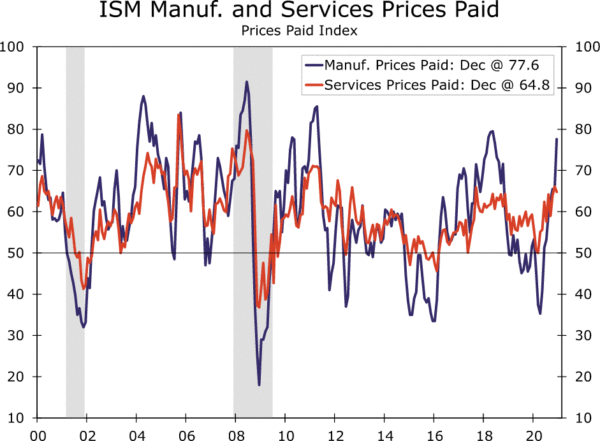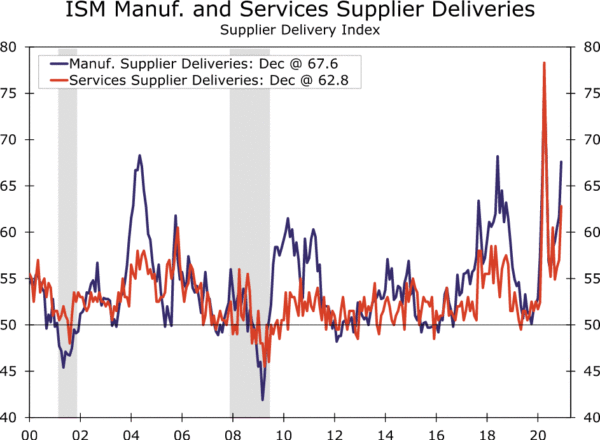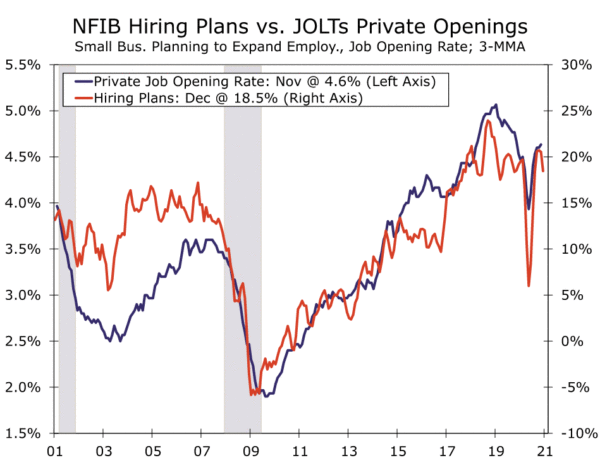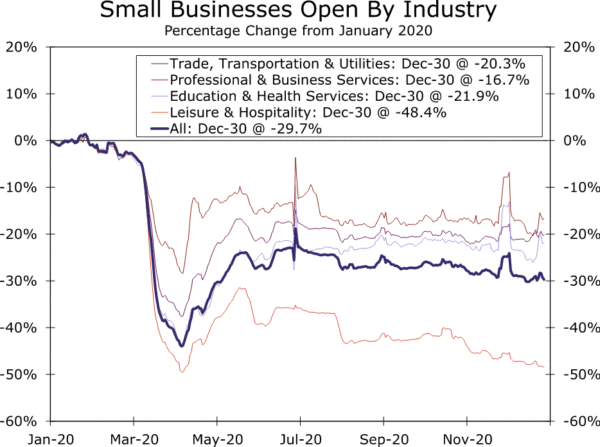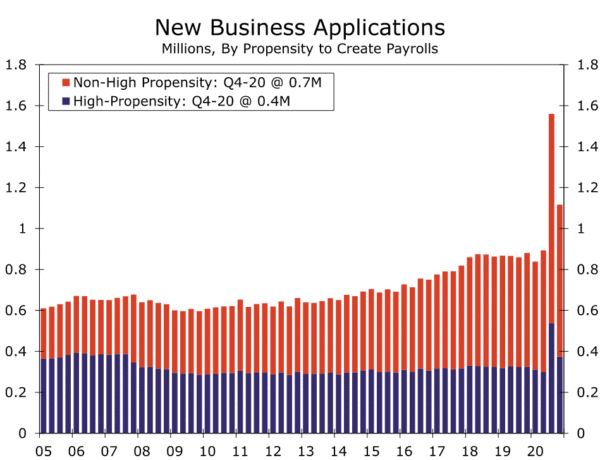Part III: Supply Constraints Drive Inflation Higher
Summary
In the second report of our series on economic risks in the foreseeable future, we looked at how demand-side factors could potentially lead to significantly higher inflation in the United States in coming years. In this third installment, we extend our analysis to consider the supply-side factors that could potentially contribute to higher inflation.
It’s not just the demand environment that has been altered by COVID. The sudden shift in spending patterns has thrown a wrench into finely-tuned supply chains, and the healthcare crisis has created staffing challenges across the goods- and services-producing sectors. Input costs for materials and labor are rising as a result.
Supply-side pressures may extend beyond the throes of the pandemic. The labor market appears to be tighter than suggested by the 9.8 million deficit in nonfarm payrolls, with job openings and hiring plans already back to levels seen late in the last cycle. Employers may see wage pressures emerge later this year if retirements are pulled forward and/or workers are slow to return to the labor force due to changes in the way they balance work and family. Because labor represents the largest cost for many businesses, the tight labor market could lead firms to raise prices in anticipation of higher costs. Surviving businesses in hard-hit sectors may find it particularly easy to do so with the pandemic knocking competitors out of the market.
Although we see supply-side factors generating higher cost pressures this year, upward pressure on prices should start to subside thereafter. Many of the current supply-side sources of inflation, like staffing issues and a scramble for materials, are likely to abate at the same time that the demand-driven pressures we highlighted in our previous report wane. Meanwhile, although the pandemic has led to a wave of business closures, credit is generally available and inexpensive, and the crisis has sparked a surge in entrepreneurship. As a result, new capacity could return quickly to the market and keep inflation from breaking significantly higher.
Could Supply-Side Factors Add to Inflationary Pressures This Year?
In our recently released second report in this series of economic risks, we focused on the potential of demand-side factors to lead to significantly higher U.S. inflation in the next few years. In short, we look for a modest increase in rates of consumer price inflation later this year. Not only do year-over-year comparisons become favorable for higher rates of inflation starting in the spring, but prices of many services could be boosted later this year, at least temporarily, by robust consumer spending when the economy fully reopens.
But we also noted in that report that inflation is a process. It takes more than just a one-off increase in prices to bring about a lasting increase in inflation. In that regard, inflation expectations need to rise to bring about price acceleration on a sustained basis. If individuals and businesses expect the inflation rate to rise higher in the future, then they often change their behavior by, for example, bringing purchases forward which then adds to upward pressure on prices. Expectations of inflation often lead to higher inflation in actuality.
Inflation expectations have edged higher in recent months, but they would need to rise meaningfully further for an ongoing acceleration in consumer prices to occur. Although pent-up demand for delayed spending on some services (e.g., restaurant dining, travel, etc.) could boost their prices later this year, growth in consumer spending should subsequently downshift after the initial burst subsides. But, the fallout on the supply side of the economy from the pandemic could add more upward pressure on prices. Inflation expectations could potentially become unmoored, leading to rising inflation on an ongoing basis. We will focus our attention on the supply-side effects on inflation in the remainder of this report.
Supply Constraints Pushing Input Costs Higher—Selling Prices to Follow?
The Chinese economy more or less briefly shut down when the pandemic originated in that country early last year, which led to supply constraints around the world. But the “prices paid” component of the ISM manufacturing index, which measures prices that manufacturers pay for inputs, did not start to rise until the U.S. economy reopened in May as demand for goods soared (Figure 1). This component of the ISM manufacturing index has subsequently risen to its highest level since mid-2018, and the prices paid component of the ISM services index has also risen to multiyear highs. Delivery times faced by manufacturers and service providers have also lengthened in recent months, which could add to further upward pressure on input prices (Figure 2). This increase in input prices may have initially originated from strong demand, but the rise in costs faced by many manufacturers and service providers could lead them to raise consumer prices..
Although prices of physical inputs have increased since the spring, there are also wages and salaries to consider. The current crisis is at its heart a healthcare crisis, and staffing has been a particular issue. Companies have struggled with absenteeism as workers need to quarantine or struggle to find childcare. Hiring new staff has been hindered by workers’ health concerns, and the need to social distance has disrupted training programs for new workers. According to the Beige Book that was prepared in advance of the January 26-27 FOMC meeting, some companies are increasing wages and benefits to limit employee turnover. Although the Employment Cost Index for private sector workers was up only 2.4% on a year-ago basis in Q3-2020 (latest available data), employment costs could accelerate in coming months if the behavior reported in the Beige Book becomes more widespread.
How Long Might Supply Be Constrained?
Inflationary pressures stemming from supply constraints could potentially extend beyond the end of the pandemic. The labor market is surprisingly tight considering there are still nearly 10 million fewer jobs in the economy today compared to last February. The unemployment rate has tumbled from 14.8% in April to 6.7%, and job openings and hiring plans among small businesses have already returned to the levels seen late in the prior cycle (Figure 3). While 4 million workers have left the labor force since February, the exodus has stemmed less from discouragement over job prospects than other reasons, such as childcare and transportation issues. If some workers decide that they prefer the additional time with family the pandemic has afforded them, or if older workers who initially left the workforce due to health concerns decide to stay “retired,” businesses may struggle to staff-up even when the pandemic subsides. With labor as most businesses’ largest cost, the resulting wage pressures could lead firms to raise prices in anticipation of future costs. Growing clamor for higher minimum wages, whether at the local or federal level, may further lead businesses to increase prices to cover rising labor costs.
The supply of goods, but particularly services, has also been reduced by the pandemic. Despite government efforts to provide lifelines to businesses through programs like the Paycheck Protection Program (PPP), many establishments have closed on a permanent basis. According to Opportunity Insights, 30% fewer small businesses were open in December compared to the start of 2020 (Figure 4). Closures have been even more widespread in the leisure & hospitality sector, where pent-up demand is likely most robust. The Bloomberg Bankruptcy Index, which measures the occurrence and breadth of bankruptcies among larger companies, rose fourfold between the beginning of 2020 and its peak in August, although it came nowhere close to reaching the highs it set in 2009. With competitors knocked out of the market, businesses keen to recoup revenues after a tough 2020 may find it easier to raise prices once demand fully recovers.
Are Fears of Supply-Side Inflation Potentially Overblown?
Although we see supply-side factors generating higher cost pressures this year, upward pressure on prices should start to subside thereafter. For starters, the pandemic-induced supply chain issues that have led to bottlenecks likely will ease as COVID is better controlled. Staffing should become less of a challenge once vaccinations are more widely available, allowing businesses to more easily meet orders. Furthermore, consumer spending on goods has been pulled forward due to the necessity to stay at home. We look for spending on goods to decelerate considerably later this year, which will also help businesses fill backorders and alleviate upward pressure on prices. In short, many of the current supply-side sources of inflation are likely to abate at the same time that the demand-driven pressures we highlighted in our previous report wane, specifically when the pandemic fades and activity returns to “normal.”
Some other medium-term supply constraints discussed in the previous section may also turn out to be more benign than feared. Although a significant number of businesses have closed and many more are barely holding on, we see scope for new businesses to form in their stead. Data on the rates that banks charge small businesses are not readily available, but tight spreads on investment grade and high-yield corporate bonds suggest that credit to new and small business likely remains generally available, unlike the 2008-2009 recession (Figure 5). Household balance sheets are also far stronger than they were coming out of the last crisis, giving entrepreneurs more financial resources to tap to form new businesses. In that regard, new business formation, including businesses likely to hire employees, has surged since the pandemic began (Figure 6). As a result, it might not take a significant amount of time for the economy’s capacity to begin growing again, which should also help to alleviate upward pressure on consumer prices.
Workers may return to the labor market in short order as well. Labor force participation is positively correlated with job availability. The pandemic has complicated that relationship, as individuals have to weigh job opportunities with health and family considerations. But, as we discussed in a report earlier this year, we expect to see a fairly fast recovery in labor force participation once the pandemic comes to an end, fueled by a surge in economic activity and lessening constraints around health and child care. Job losers who have left the labor force may also find the financial need to return to work more pressing when unemployment benefits are eventually exhausted and/or weekly payments are reduced. As a result, we believe there is a “relief valve” when it comes to labor cost pressures later this year when activity does begin to normalize.
Conclusion
Inflation has the potential to move higher this year not only due to stronger demand as we discussed in Part II, but also from the COVID crisis straining the supply side of the economy. Input costs are rising for materials and labor as supply chains are gummed up, which could put some upward pressure on consumer prices, at least in the near term. The fall in the labor force participation rate and business closures in the wake of the pandemic could potentially boost consumer prices further. If price increases lead to expectations of higher future inflation, then an environment of stronger price growth on a sustained basis could be set in train.
That said, we expect that countervailing forces will keep the inflation outlook largely benign after the initial one-off increase in prices this year. For starters, bottlenecks should ease later this year once vaccines become widely deployed and businesses can operate at higher capacity again. The combination of greater supply and deceleration in consumer spending on goods should alleviate upward pressure on goods prices. Credit generally remains widely available, which should be supportive of new business formation and expansion of existing businesses. We also look for the labor force participation rate to resume its modest upward trend that was in place prior to the pandemic.
Furthermore, not all businesses are in a position where they need to increase prices despite the recent rise in costs. Corporate profits as a share of nominal GDP, a proxy for margins, remains historically high. In other words, many firms are not so squeezed to where they are desperate to raise prices; we suspect some costs will be absorbed rather than full passed on. In the next part of our series on risks to the economic outlook, we look at the potential for margins to be squeezed from higher costs this year, and how risks to the profit outlook may affect investment and employment.




